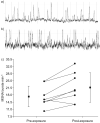Sleep apnoea syndrome in 2011: current concepts and future directions
- PMID: 21881142
- PMCID: PMC9584111
- DOI: 10.1183/09059180.00003111
Sleep apnoea syndrome in 2011: current concepts and future directions
Conflict of interest statement
None declared.
Figures





 : IH. Reproduced from [31] with permission from the publisher.
: IH. Reproduced from [31] with permission from the publisher.References
-
- Young T, Peppard PE, Gottlieb DJ. Epidemiology of obstructive sleep apnoea: a population health perspective. Am J Respir Crit Care Med 2002; 165: 1217–1239. - PubMed
-
- White DP. Pathogenesis of obstructive and central sleep apnea. Am J Respir Crit Care Med 2005; 172: 1363–1370. - PubMed
-
- Boyd JH, Petrof BJ, Hamid Q, et al. . Upper airway muscle inflammation and denervation changes in obstructive sleep apnea. Am J Respir Crit Care Med 2004; 170: 541–546. - PubMed
Publication types
MeSH terms
LinkOut - more resources
Full Text Sources
Medical
